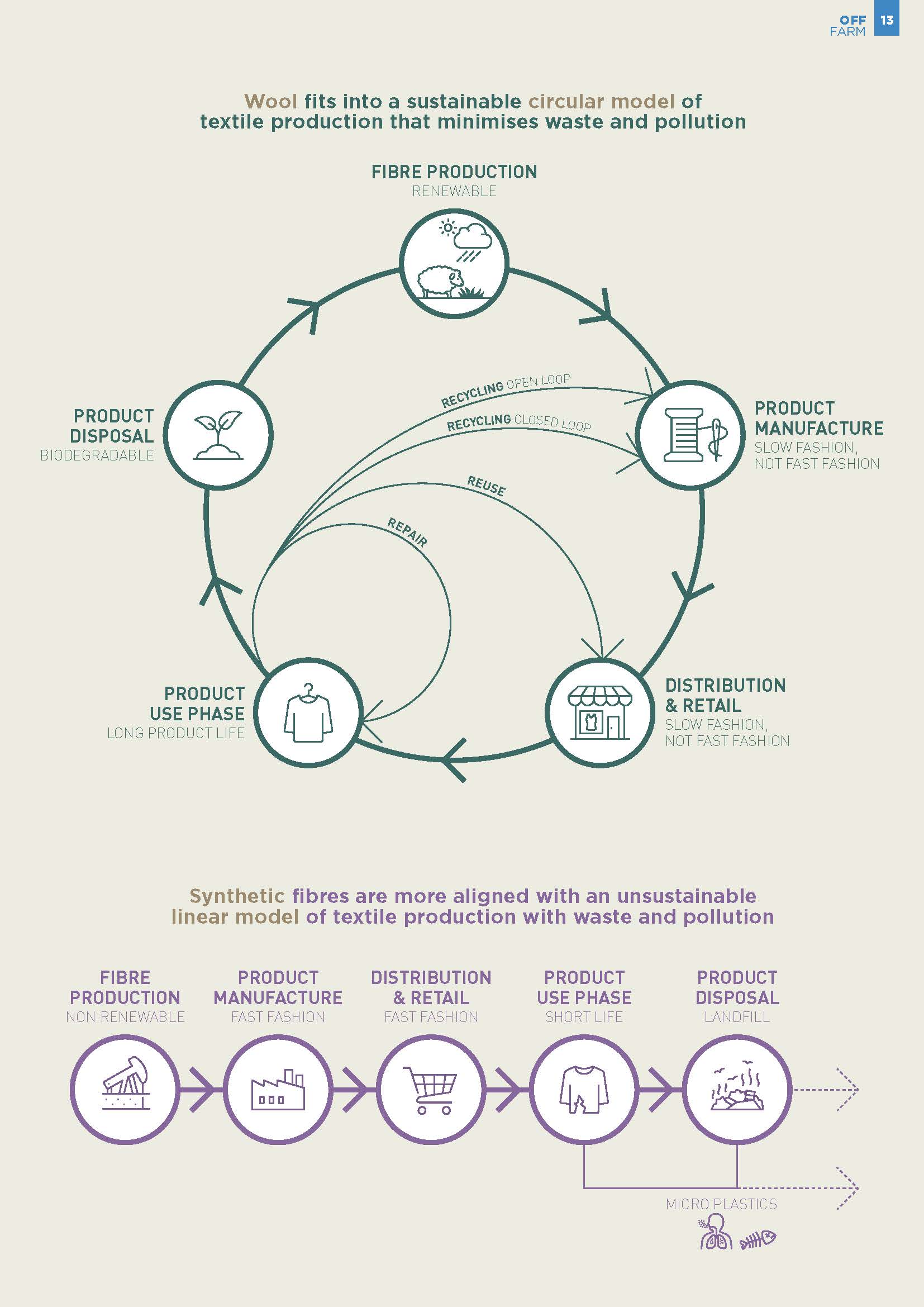
With the global fashion and textile industry under pressure from consumers and regulators to reduce its waste and pollution, there is a push for the supply chain to change its method of production from a wasteful 'linear' model towards a sustainable 'circular' model. Wool has a unique set of 'circular' features – such as being a renewable and biodegradable fibre, and suitable for reuse and recycling – which should make the fibre more sought after by companies along the supply chain including brands and retailers.
When looking at many of the environmental issues that today's society is facing, it is becoming clear to many that the current 'linear' model of textile production has reached its limits and is no longer working for people nor the planet. This is why brands, manufacturers, regulators and NGOs see a solution in a different economic model – the 'circular' economy.
The circular economy is based on the principles of:
- using renewable resources
- designing out waste and pollution
- keeping products and materials in use for a long time; and
- regenerating natural systems.
Many brands and designers are asking themselves how they can shift into a circular business model and create circular products. The answer is wool.
In stark contrast to synthetic fibres, wool is by nature a circular fibre (see above). In the Material Circularity Indicator by the Ellen MacArthur Foundation, wool gets the highest score possible.
AWI supports the movement towards a more circular fashion industry to better compete with synthetics.
Through the company's marketing arm, The Woolmark Company, AWI is increasingly championing and educating brands and the supply chain about wool's innate circular attributes. It is vital that The Woolmark Company continues to provide the scientific evidence and a pathway for companies to incorporate wool into their products to lighten their eco-footprint and demonstrate an alignment to circularity.
Regulatory pressure in the EU
Aside from a self-initiated push by the global fashion and textile industry towards a circular economy and a slowing down of fast fashion, there are growing regulatory pressures, especially in the European Union (EU), to force the industry to adopt the circular economy.
A comprehensive policy and legislative framework to achieve circularity in the textile industry is being developed through the EU's European Green Deal and its Circular Economy Action Plan. Addressing waste and pollution in the textile industry is a key goal of the EU's plans.
Adoption can be expected by member states within two years. Other jurisdictions may well follow.
The strategy aims to help the EU shift to an economy in which fashion and textile products are designed to be more long-lasting, reusable and recyclable, and encourage sustainable production. Furthermore, through the EU's Extended Producer Responsibility legislation, brands will soon be responsible for the entire life-cycle of their products (production and post-retail) including take-back, recycling and final disposal.
Brands must start designing for circularity.
The wool industry is unique in having a package of circular features that align and show excellent fit with the EU's European Green Deal principles.
AWI is engaged at an EU level, drawing on its extensive research in this space and working with the International Wool Textile Organisation (IWTO), to champion Australian wool throughout the EU's policy and legislative development process. AWI is also engaging with its brand and supply chain partners to raise awareness of the regulatory sharing and share the company's research and analysis.
FIBRE PRODUCTION
Every year, sheep produce a new fleece, making wool a completely renewable fibre source. Wool is grown in the simple mix of sunshine, water, grass and fresh air. In contrast, synthetic fibres are derived from non-renewable petrochemicals and fossil fuels, which when extracted de-sequester carbon stored millions of years ago.
PRODUCT USE PHASE
How often clothes are worn is the most influential factor in determining environmental impacts from clothing. Wool garments are on average kept in use for longer periods of time than garments made from other fibre types (and are very suitable for repair if needed).
In addition, consumers wash wool clothing less frequently than other fibre types, saving water, energy and detergent associated with laundering.
Wool's attributes are so highly valued that, even after a garment has finished its long service life with one person, the fibre is still suitable to be kept in use via three further ways:
1st life extension – Reuse: Wool is the most reused fibre on the planet of the major apparel fibres, with wool garments often preferentially donated for extended life.
2nd life extension – 'Closed loop' recycling: This involves high-value wool garments deconstructed to enable new yarns to be spun and new high-value garments fabricated. Wool is the most recyclable fibre on the planet of the major apparel fibres.
3rd life extension – 'Open loop' recycling: This is essentially 'down cycling', in which wool products are pulled apart and fabricated into cheaper non-woven products for insulation, padding, interiors etc.
PRODUCT DISPOSAL
Wool is made of a 100% natural biodegradable protein, similar to that found in human hair. When a wool product reaches its end-of-life and is disposed of, the wool fibre readily decomposes in soil, slowly releasing valuable nutrients and carbon back into the earth, acting like a fertiliser. In contrast, synthetic fibres do not biodegrade but instead accumulate in landfill and release microplastics.
This article appeared in the March 2021 edition of AWI's Beyond the Bale magazine. Reproduction of the article is encouraged, however prior permission must be obtained from the Editor.






